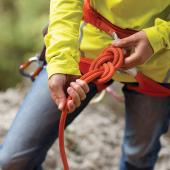Keep's Craw
Early summer in Southwest Montana is typically striped with muddy, raging rivers full of the melted snows of winter. Most anglers this time of year seek out tailwater fisheries and lakes. The-stout of-heart, however, know that trout still have to eat, and that they often seek shelter near the shorelines of our major rivers. One staple of the trout throughout the year is the crayfish. Over the last three years, local tier Shane Keep has developed a pattern that mimics the crayfish in both color and behavior, and it has become a staple in his box, as well as the bins of several local fly shops. It is a joy to tie, and the numerous large trout chasing it toward your stripping hand will inspire you to tie more.
Materials
Hook: Dai-Riki 270 #4 (Natural bend nymph hook, 3x long)
Thread: Dark Brown Uni-Thread 6/0
Body: Coarse brown dubbing blended with tan sparkle dub
Claws: Dark brown Zonker Strips
Antennae: Dark brown Sili Legs and Copper Crystal Flash
Eyes: 15 pound Maxima leader material melted and then cooled
Shell: 1/4" Scud Back or Thin Skin cut into 1/4" strips
Hackle: Brown grizzly hen hackle
Lead eyes: Large size 1/4" lead dumbbell eyes
Rib: Small copper wire
Instructions
1. To begin, wrap thread on a natural bend nymph hook from the eye until it is even with the point of the hook. Either spin the hook upside down now, or if you don’t have a rotary vise, remove the hook and place it in the jaws upside down.
2. Tie in the monofilament eyes on each side of the hook.
3. Tie in one strand on each side of the copper Crystal Flash and brown Sili Legs. Each of these ingredients is pointing toward the bend of the hook.
4. Tie in a strand of 1/4" Scud Back and leave it trailing away from the shank. Now you can wrap a large ball of waked dubbing over the thread wraps and antennae tie-in point. Behind this ball, tie in the one-inch claws, and place a drop of Zap-A-Gap over the thread at the tie in point.
5. Behind the claws, tie in the stem of the hackle feather.
6. Tie in a strand of small copper wire. Proceed dubbing the rest of the body toward the eye of the hook. Do this in such a manner that the body tapers toward the eye. Leave 1/8" space to tie in the dumbbell eyes.
7. Place the eyes on the opposite side of the hook (the traditional top of the hook shank) in a drop of Zap-A-Gap and tie by crossing the thread over the notch in the eyes. Dub over your thread wraps around the dumbbell.
8. Palmer the feather toward the lead eyes, and tie off and trim the excess. Place the thread near the eye of the hook.
9. Now spin the hook so the shank is on top. Spread the hackle fibers, and pull the scud back over them and tie off near eye.
10. Trim the scud back at tip of eye. Wrap the wire over all of this and tie off, whip finish, and cement.
Keep says that his favorite way to fish the Craw is to cast it upstream and across the current, throw in a large upstream mend, and then strip it with long, slow tugs. Though this is his preferred technique, he has also caught fish with it cast straight upstream and straight downstream, but always with a lot of "action" incorporated into the retrieve. Fall is a dynamite time to fish the Craw, but this summer, as the high muddy waters begin to recede, fish it close to the banks for hefty trout seeking their first post-runoff feast.
Jeff Hostetler is a full-time instructor at Gallatin College. He spends his winters riding at Bridger and the rest of the year fly fishing southwest Montana.











